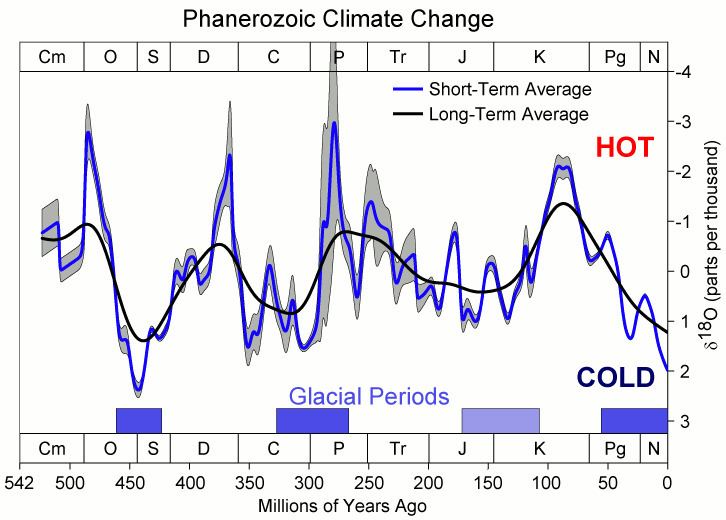Knowledge of precise climatic events decreases as the record goes further back in time. Some notable climate events known to Paleoclimatology are listed here. The Timeline of glaciation covers ice ages specifically, which tend to have their own names for phases, often with different names used for different parts of the world. The names for earlier periods and events come from geology and paleontology. The Marine isotope stages (MIS) are often used to express dating within the Quaternary.
Scale: Millions of years before present, earlier dates approximate.
Before 1,000 Mya Faint young Sun paradox
2,400 Mya Great Oxygenation Event probably leads to Huronian glaciation perhaps covering the whole globe
650 - 600 Mya Later Neoproterozoic Snowball Earth or Marinoan glaciation, precursor to the Cambrian Explosion
517 Mya End-Botomian mass extinction; like the next two, little understood
502 Mya Dresbachian extinction event
485.4 Mya Cambrian–Ordovician extinction event
450 - 440 Mya Ordovician–Silurian extinction event, in two bursts, after cooling perhaps caused by tectonic plate movement
450 Mya Andean-Saharan glaciation
360-260 Mya Karoo Ice Age
305 Mya cooler climate causes Carboniferous Rainforest Collapse
252.17 Mya Permian-Triassic extinction event
199.6 Mya Triassic–Jurassic extinction event, causes as yet unclear
66 Mya, perhaps 30,000 years of volcanic activity form the Deccan Traps in India, Or a large meteor impact.
66 Mya Cretaceous–Paleogene boundary and Cretaceous–Paleogene extinction event, extinction of dinosaurs
55.8 Mya Paleocene-Eocene Thermal Maximum
53.7 Mya Eocene Thermal Maximum 2
49 Mya Azolla event may have ended a long warm period
5.3 - 2.6 Mya Pliocene climate became cooler and drier, and seasonal, similar to modern climates.
2.5 Mya to present Quaternary glaciation, with permanent ice on the polar regions, many named stages in different parts of the world
All dates are approximate. "(B-S)" means this is one of the periods from the Blytt-Sernander sequence, originally based on studies of Danish peat bogs.
120,000 - 90,000 BP Abbassia Pluvial wet in North Africa
110,000 - 10,000 BP Last glacial period, not to be confused with the Last Glacial Maximum or Late Glacial Maximum below
50,000 - 30,000 BP Mousterian Pluvial wet in North Africa
26,500 - 19,000–20,000 BP Last Glacial Maximum, what is often meant in popular usage by "Last Ice Age"
16,000 - 13,000 BC Oldest Dryas cold, begins slowly and ends sharply (B-S)
12,700 BC Antarctic Cold Reversal warmer Antarctic, sea levels rise
12,400 BC Bølling oscillation warm and wet in the North Atlantic, begins the Bølling-Allerød period (B-S)
12,400 - 11,500 BC (much discussed) Older Dryas cold, interrupts warm period for some centuries (B-S)
12,000 - 11,000 BC Allerød oscillation warm & moist (B-S)
11,400 - 9,500 BC Huelmo/Mascardi Cold Reversal cold in Southern Hemisphere
11,000-8,000 BC Late Glacial Maximum, or Tardiglacial (definitions vary)
10,800 - 9,500 BC Younger Dryas sudden cold and dry period in Northern Hemisphere (B-S)
All dates are BC (BCE) and approximate. "(B-S)" means this is one of the periods from the Blytt-Sernander sequence, originally based on studies of Danish peat bogs.
from 10,000 Holocene glacial retreat, the present Holocene or Postglacial period begins
9,400 BC Pre-Boreal sharp rise in temperature over 50 years (B-S), precedes Boreal
8,500 - 6,900 BC Boreal (B-S), rising sea levels, forest replaces tundra in northern Europe
7,500 - 3,900 Neolithic Subpluvial in North Africa, wet
7,000 - 3,000 BC Holocene climatic optimum, or Atlantic in northern Europe (B-S)
6,200 BC 8.2 kiloyear event cold
5,000 - 4,100 BC Older Peron warm and wet, global sea levels were 2.5 to 4 meters (8 to 13 feet) higher than the twentieth-century average
3,900 BC 5.9 kiloyear event dry and cold, ends Neolithic Subpluvial in North Africa, expands Sahara Desert
3,200 - 2,900 Piora Oscillation, cold, perhaps not global. Wetter in Europe, drier elsewhere, linked to the domestication of the horse in Central Asia.
2,200 BC 4.2 kiloyear event dry, lasted most of the 22nd century BC, linked to the end of the Old Kingdom in Egypt, and the Akkadian Empire in Mesopotamia, various archaeological cultures in Persia and China
1800-1500 BC Middle Bronze Age Cold Epoch, a period of unusually cold climate in the North Atlantic region
Bond Event 2 - possibly triggering the Late Bronze Age collapse
900 - 300 BC Iron Age Cold Epoch cold in North Atlantic
250 BC - 400 AD Roman Warm Period
250 BC–400 AD Roman Warm Period
Climate changes of 535-536 (535–536 AD), sudden cooling and failure of harvests, perhaps caused by volcanic dust
900–1300 Medieval warm period, wet in Europe, arid in North America, may have depopulated the Great Plains of North America, associated with the Medieval renaissances in Europe
Great Famine of 1315–17 in Europe
Little ice age: Various dates between 1250 and 1550 or later are held to mark the start of the Little ice age, ending at equally varied dates around 1850
1460–1550 Spörer Minimum cold
1656–1715 Maunder Minimum low sunspot activity
1790–1830 Dalton Minimum low sunspot activity, cold
Year Without a Summer (1816), caused by volcanic dust
1850–present Retreat of glaciers since 1850, instrumental temperature record
present and recent past global warming, perhaps to be named the Anthropocene period

